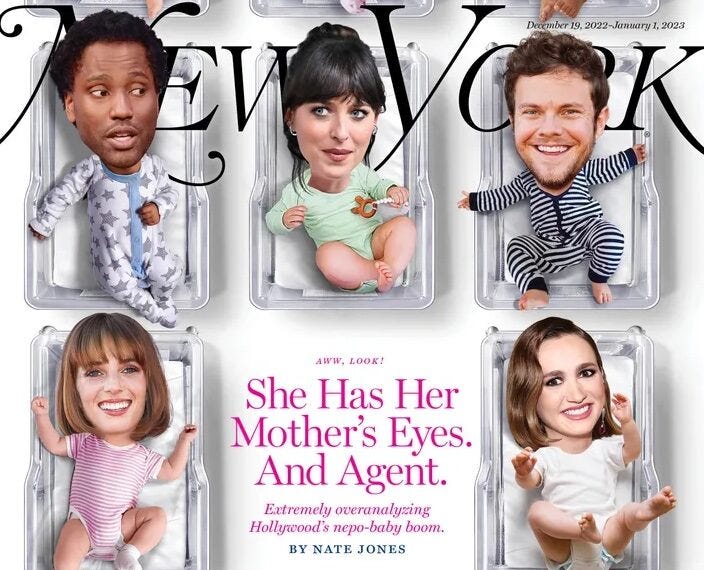How Nepotism Took Over Marketing
Understanding the hidden influence that determine which campaigns get greenlit, which agencies get hired, and who really calls the shots
Once a dirty little secret, nepotism is now headline news, dissected in New York Times op-eds, roasted on Twitter, and memeified across TikTok under the now-iconic label: Nepo Baby.
But this isn’t just a Hollywood drama.
Nepotism has quietly shaped the marketing industry, influencing everything from who lands top campaigns to who gets hired at agencies, whose decks are seen, and whose ideas actually get made.
And it’s time we had an honest conversation about it.
But first, what is nepotism? Well, it refers to the practice of favouring relatives or close friends, especially by giving them jobs or advantageous treatment in professional settings.
The term originates from the Italian word nepotismo, rooted in the Latin nepos, meaning nephew, a reference to the preferential treatment given by Renaissance-era popes to their illegitimate nephews in the church hierarchy.
In modern business, nepotism often manifests in more subtle ways: fast-tracked promotions, preferential contract awards, or early exposure to insider knowledge.
While often brushed aside as “networking,” the power dynamics at play go far beyond typical career support.
Why does this matter?
In marketing, it doesn’t always look like blatant handouts. It can be:
A legacy hire at an agency
A director’s child fast-tracked to a global campaign
An influencer sibling plugged into a major brand deal
Or someone with the right last name casually jumping over years of ladder-climbing
It often hides under the guise of "fit," "trust," or "creative chemistry", but the power imbalance is real.
When we think of celebs and nepotism I immediately think of The Kardashian-Jenners, who didn’t just benefit from nepotism, they weaponised it.
From SKIMS to Kylie Cosmetics, they turned family branding into billion-dollar verticals. Their success helped normalise the idea that family-first is a viable, even preferable, brand strategy.
But they’re not alone.
LVMH placed multiple Arnault children in key executive roles across brands like Louis Vuitton and Tiffany.
Publicis Groupe has long been shaped by Elisabeth Badinter, daughter of founder Marcel Bleustein-Blanchet.
Martin Sorrell’s son went from finance to deals at WPP to joining his father’s new firm, S4 Capital.
It’s not a coincidence.
So, who’s not getting the gig?
That’s where the conversation really matters. When creative roles are increasingly filled by insiders, by family, friends, and former interns of CMOs, that means:
Fewer fresh voices
Less socioeconomic diversity
More sameness in the stories brands tell
Talented strategists, designers, and thinkers from underrepresented or non-legacy backgrounds are being edged out of opportunities before they even hear about them.
And even when they do, they're often facing biased evaluations shaped by trust networks they’re not part of.
The hidden job market is family-based: Many roles are never advertised, circulating instead within tightly-knit networks.
Evaluation standards vary: Work by well-connected individuals is often viewed more generously, consciously or not.
These informal networks act as shadow approval structures, unofficial but deeply influential routes through which decisions are made.
When hiring favours familiarity, the campaigns we see reflect a narrow perspective. We lose:
The authentic Gen Z work from creatives outside London/NY/LA bubbles
The insights from first-gen marketers who know how to talk to overlooked communities
The weird, beautiful, messy ideas that come from creative tension, not generational echo chambers
It’s how you end up with out-of-touch Super Bowl ads and PR disasters that could’ve been avoided if someone in the room had the life experience to say: “Yeah, that’s not it.”
But, is it really that bad?
Let’s be honest, nepotism isn’t just a marketing industry thing.
It’s everywhere. From the corner shop where the owner's kid learns how to run the register, to the family-run law firm downtown, to the billion-dollar fashion house with a last name stamped on every label.
It’s part of how humans operate: we pass on knowledge, opportunities, and resources to people we trust, and often, that means people close to us.
You’ll find it:
In the family-owned deli where the third generation is already learning inventory at 12
In independent design studios, where siblings start creative partnerships
In entertainment, where legacy actors land their first roles through uncles, cousins, or godparents
In media and fashion, where internship pipelines quietly favour kids from "the right" neighbourhoods and schools
In many ways, nepotism can build continuity, preserve institutional knowledge, and create strong internal culture. It’s why family businesses are often some of the most resilient and long-lasting.
But here’s where people believe it gets tricky in modern marketing: when the same names get the same opportunities, year after year, the result isn’t just “trust.” It’s stagnation.
When markets change faster than institutions, relying on family or inner-circle hires doesn’t just limit access, it limits creativity.
So what now?
You can’t fight nepotism with idealism, you fight it with access, visibility, and strategy. If you're not from "the room," here's how to break into it (or build your own):
Be public with your work, on LinkedIn, Twitter, Notion, wherever.
Develop POVs, not just portfolios, show how you think, not just what you did.
Find your crew, align with other outsiders and grow together.
Stay curious about how power flows. If you understand the game, you can hack it
Until next time, keep listening, keep learning, and keep evolving.
And make sure you digress often. Curiosity is key to winning in this game.
Charlotte









Love this! I’m Harrison, an ex fine dining industry line cook. My stack "The Secret Ingredient" adapts hit restaurant recipes (mostly NYC and L.A.) for easy home cooking.
check us out:
https://thesecretingredient.substack.com
This is a great piece